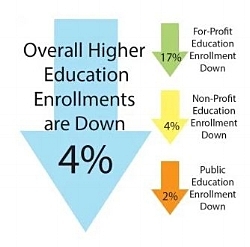Online Course Development
Terri has managed instructional design teams creating traditional higher education core content. She has also created online courses for learning about the State Authorization Reciprocity Agreements (SARA) including SARA 101: An Overview of SARA, Foundations of NC-SARA Annual Data Reporting, and Preparing for and Maintaining SARA Participation. Courses were developed using Articulate Rise and are delivered using the Litmos learning management system.
Learn more about these online courses and register to explore the courses at the SARA Learning Station using the button below.
Distance Education Blog Posts
Sampling of Blog Posts written for WCET Frontiers
Distance Education Enrollment Growth—Major Differences Persist Among Sectors
With the 2016 IPEDS distance education data now available, we have four years of sector data and many of the trends we first identified in 2013 have continued. Looking more closely at the sector trends illuminates some changes that might be missed by looking solely at consolidated distance education data. Public institutions of higher education continue to educate nearly three-fourths (73.0% in 2016) of all enrolled students, regardless of mode of delivery.
Count All Students! New Outcome Measures Now Include Non-Traditional Students
There is new improvement to the U.S. Department of Education’s Graduation Rate statistic. And we should all be using it. Institutions with large non-traditional student enrollments (e.g.: community colleges, online colleges, inner city universities, military-serving institutions) have not been well-represented by the Department’s Graduation Rate statistic.
IPEDS Fall 2013: Distance Education Data Reveals More Than Overall Flat Growth
For the first time, we have two sets of IPEDS Distance Education (DE) data. The industry is anxious to have benchmark data that will help us determine trends in the marketplace.
It is important to understand the enrollment trends by sector. While all sectors report declining enrollment, between 2012 and 2013, the retrenchment in the For-Profit sector, with a decline of 17%, is significantly greater than the other two sectors.















